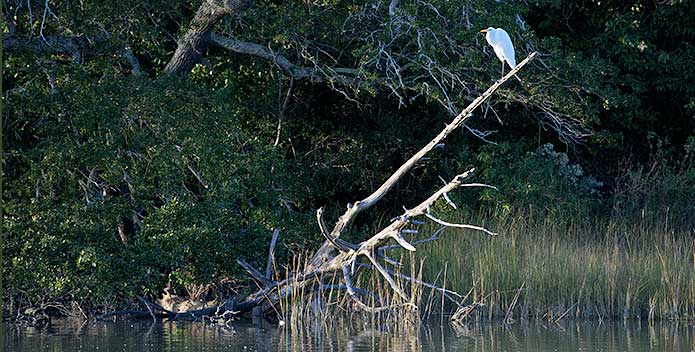What have you seen lately? If you identify a bird at Pleasure House Point that's not on our list (below) send an e-mail (with a picture if you have one) to [email protected].
Given its location near the mouth of the Lynnhaven River and Chesapeake Bay, Pleasure House Point is alive with bird life. This 122 acre mix of beach, wetlands, marsh, old-growth maritime forest, and shallow-water habitat provides breeding, migrating, and wintering habitat important to the future of several species. This is one of the reasons CBF and its conservation partners are seeking to preserve this important natural area.
A mid-winter birding expedition led by Bill Portlock, CBF Senior Educator for the Bay, in January 2011 identified 28 species of birds. The complete list is provided below.
-
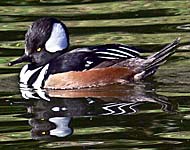
Lee Karney (USFWS)
Hooded Merganser
(Lophodytes cucullatus)The Hooded Merganser is a species that prefers secluded areas around wooded ponds, lakes, and streams. The major threat to these stunning birds is habitat loss, as they rely on cavities of large, mature trees for their nesting sites. One of North America's least numerous and most secretive ducks, they dive for their diet of insects, crustaceans, small fish, and vegetation.
-
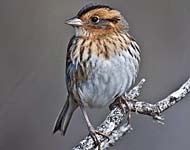
Marlin Harms (CC BY 2.0)
Nelson's Sharp-tailed Sparrow
(Ammodramus nelson)The Nelson's Sharp-tailed Sparrow is an unobtrusive little bird that can be found in three distinct, geographically separated habitats. One is the mature, undisturbed coastal marshes of the eastern seaboard. They can be found in the Chesapeake Bay region year-round. Their diet depends on insects and small crustaceans found in dense grasses, mudflats, tidal pools, and wrack lines. The Nelson's Sharp-tailed Sparrow is threatened by an acute loss of breeding, migrating, and wintering habitat with the continued destruction of coastal marshes. Conservation of extensive salt marsh is critical to the species' future.
-
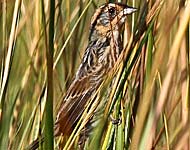
Seabamirum (CC BY 2.0)
Saltmarsh Sharp-tailed Sparrow
(Ammodramus caudacutus)These little birds need large coastal marshlands—especially those around estuaries like the Chesapeake Bay—dominated by grasses for breeding and winter habitat. With a wider diet than Nelson's Sharp-tailed Sparrow, it forages for small crabs, small mussels, immature insects, and the seeds of marsh plants such as cordgrass and saltbush. This bird has a limited range, which makes the loss of habitat even more of a concern. The Saltmarsh Sharp-tailed Sparrow is also affected by toxic environments and by invasive species, such as phragmites, which is unsuitable for nesting.
-
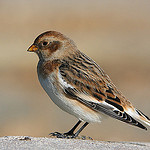
M. Kilner (CC BY 2.0
Snow Bunting
(Plectrophenax nivalis)The southernmost range of the Snow Bunting reaches just below the Chesapeake Bay. These small birds winter along the shores of the Bay, lakes, and rivers where grass and grain fields are plentiful and the land is relatively open. Threatened by global warming in its northern home of the Alaskan and Canadian tundra, its southern habitat is threatened by the loss of open sites, like that at Pleasure House Point.
Species found on Pleasure House Point January 2011
- Great Blue Heron
- Bufflehead
- Red-breasted Merganser
- *Hooded Merganser
- Osprey
- Great Black-backed Gull
- Herring Gull
- Ring-billed Gull
- Double Crested Cormorant
- American Crow
- Fish Crow
- Mallard
- Pied-billed Grebe
- Song Sparrow (heard)
- *Nelson's Sharp-tailed Sparrow
- *Saltmarsh Sparrow
- Kingfisher
- American Goldfinch
- *Snow Bunting
- Bald Eagle
- Red-tailed Hawk
- Downy Woodpecker
- Starling (European)
- Rock Pigeon
- Mourning Dove
- Dark-eyed Junco
- White-throated Sparrow
- Turkey Vulture
Other species that typically may be observed in this area or at other times of the year would include:
- Brown Pelican
- Savannah Sparrow
- Seaside Sparrow
- Terns: Royal, Common, Least, Forster's, Caspian (depending on time of year)
- Laughing Gull (summer)
- Woodpeckers: Downy, Hairy, Red-bellied, Pileated, Yellow-bellied Sapsucker, Northern Flicker
- Smaller perching birds: Chickadees, Titmice, Brown Creeper, Golden-crowned and Ruby-crowned Kinglets, Eastern Bluebirds, Blue Jays
- Rails: Clapper, Virginia (maybe Sora )
- Snowy Egret (uncommon in winter)
- Tri-colored Heron
- Shorebirds at low tide: Sandpipers, Plovers, Willets, Oystercatchers, Black Skimmers
- Great Egret (present spring/summer/fall)
Learn more about regional birds with Audubon Guides.

